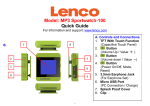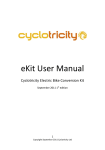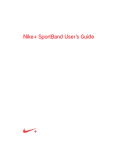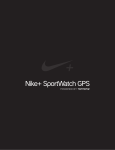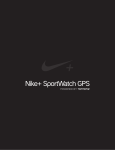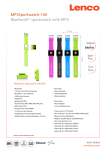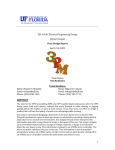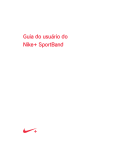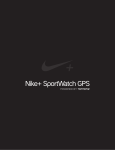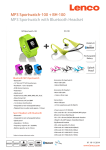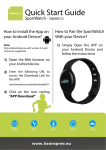Download TomTom GPS Systems User Manual
Transcript
Welcome Welcome to your Nike+ SportWatch GPS, powered by TomTom. Your watch works with GPS and the Nike+ Sensor in your shoe to record your distance, pace, elapsed time and calories burned while you run. You can tap the screen to record laps as you run. After your workout, connect the watch to a USB port on your computer to upload your runs to nikeplus.com, see where you ran, set personal goals, challenge your friends, and find great routes. Getting Started TO USE YOUR NIKE+ SPORTWATCH GPS, YOU MUST HAVE: • A Macintosh with built-in USB. Mac OSX v10.4.8 or later or • A PC with built-in USB or a USB card installed. Windows XP Home or Professional (SP2) or later, or Windows Vista or Windows 7. • Internet access. Broadband is recommended; fees may apply. Usage is subject to the terms of a software license. WHAT’S INCLUDED 1 clock run history records stopwatch 2 4 3 1. Nike+ SportWatch GPS 4. Quick Start Guide 2. Nike+ Sensor 5. Nike+ Connect Software 3. USB cable 5 Icons Satellite: GPS satellite signal ShoePod: Nike+ Sensor for your shoe Heartrate: heart rate transmitter (sold separately) Battery: battery charge Warning: battery or memory is low Alarm: Alarm is set Scroll, Select, Tap fig. 01 1. Scroll 3. Tap 2. Select As you use your SportWatch GPS, you’ll tap, select and scroll. 1. Scroll: review your options, up or down. 2. Select: chose an option on the screen, or pause your run 3. Tap: mark laps as you’re running, or turning on the backlight. Your watch is designed for quick, but strong taps, to avoid light, accidental taps while you’re running. This isn’t a touch screen. The Fastest Way to Get Up & Running Ready linking 3 sec start cancel cancel Press and hold the Select button for 3 seconds. The satellite icon will blink until a signal is found. You can’t use GPS unless you’re outside. When you see “Ready,” press the Select button to start your run. Stat Loop pace 8 33 0 02 avg pace /MI DISTANCE speed avg speed distance elapsed MI lap time Paused 3.57 mi continue end 3 sec Run Ended calories clock As you run, use the scroll button to toggle through your distance, pace, average pace, elapsed time, calories or time of day. Press the Select button anytime you want to pause your run. Press and hold the Select button for 3 seconds to end your run. After your run, plug the watch strap into a USB port on your computer, and upload your run info to nikeplus.com Note: To use your watch indoors, place the shoe sensor under the sock liner of your Nike+ Ready shoe. Before Your Run You can run with your watch, right out of the box, but to get the most out of your run, plug your watch into a USB port on your computer and customize your settings using the Nike+ Connect software. Using the Nike+ Connect Software First, plug your watch into a USB port on your computer. You can also use the USB cable that came with your watch. If you’re using a Mac, click the SportWatch icon on your desktop. Double click the icon of the drive to open it, then double click the “nikeplus” file. You’ll automatically be sent to a website where you can download the Nike+ Connect software. Note: Make sure the USB connector is dry before you plug it into your computer. If you’re using a PC, click the SportWatch icon located in My Computer. Or, it might launch automatically. Download the Nike+ Connect software to your computer. Each time you connect your watch to that computer, (fig. 02) the software will automatically launch, uploading your runs to nikeplus.com, and removing them from the watch’s memory. Note: You can down download and install the software to more than one computer. fig. 02 The Nike+ Connect software allows you to customize your settings, and automatically saves your info, and closes when you unplug your watch If you’re already a Nike+ member, click on “login” and log in to your account, once the website is launched. Otherwise, click “Create an account” to create a new Nike+ account. Then you can customize your watch by clicking through the Settings. Here’s what you’ll see in the main window (fig. 03): fig. 03 1 4 3 1. 2. 3. 4. 5 2 The status area gives you a status report, in real time. For example, “All workouts uploaded.” Clicking the “nikeplus.com” button takes you to nikeplus.com. The battery icon shows you the charge level of the battery. The “settings” button opens the setting drawer, where you can customize the settings on your Nike+ SportWatch GPS. 5. Clicking “version number” shows you detailed information about which version of software and firmware you’re using on both your Nike+ SportWatch GPS and Nike+ Connect Settings Button fig. 04 settings To close the “settings” window, click the “settings” button (fig. 04). To open it, click it again, then click through the tabs on the left-hand side to customize your watch. GETTING HELP Clicking on “Help” takes you to the Support section of nikeplus.com, where you can download the user’s manual, read frequently asked questions, view tutorials and share feedback. RESETTING THE WATCH TO FACTORY SETTINGS If you want to reset all the settings back to the original factory defaults, click “Factory Reset.” This will clear your user settings, time, calibration information and “weekly” distance numbers, your account info, personal records and history. Note: When you reset the Factory Settings, the run info you ’ve already uploaded to nikeplus.com won’t be erased. Profile Tab fig. 05 YOUR USERNAME Your username will automatically appear as “pending” until you login or register at nikeplus.com. Once you’re a nikeplus.com member, and you’ve logged in through the Nike+ Connect software, your username will automatically show up. This username is specifically associated with your watch. ENTERING YOUR WEIGHT TO TRACK CALORIES BURNED To track your calories burned while you run, enter your current weight. Type in your weight, (fig. 05), then use the drop-down menu to choose pounds or kilograms. Note: If you don’t enter your weight in the Profile tab, your watch will assume a weight of 150 pounds for calculating calories. Make sure to update this with your current weight for a more accurate calorie count. SETTING THE UNITS OF DISTANCE You can adjust the units of distance to miles or kilometers. This will only affect the units of measurement on your Nike+ SportWatch GPS. Time and Date Tab fig. 06 SETTING THE TIME Your watch will automatically be set to the current time and date on your computer, once you plug your watch strap into a USB port. To adjust the time manually, click on the Time & Date tab (fig. 6), then click “Manually set the time and date” to make adjustments. You can also set the time and date on your watch. The “Manually set the time and date option” will stay selected unless you choose to set the time and date to your computer’s settings. Check the box “Use 24-hour time” for 24-hour time mode. Customize Tab fig. 07 PACE/SPEED Your watch can measure your current pace — “Pace” — or how fast you’re running — “Speed.” Use the drop down box to choose the one you prefer. Note: This change will automatically update the info in your Favorite Stat and Stat Loop. fig. 08 EDIT STAT LOOP Check all the metrics you want to see in the upper portion of your watch’s display as you run (fig. 08). You’ll push the scroll button up or down to review this info. Your options include: distance, pace or speed, average pace or average speed, elapsed time, lap time, calories, clock and heart rate. Use the scroll buttons on the image of the watch to preview what the stat loop will look like during your run. Choose “Auto Loop” if you want to see your selected stats scroll automatically as you run. Note: Heart rate won’t show up here unless your watch has previously been linked to a heart rate monitor. See more on this in the section “Adding heart rate to your run.” FAVORITE STAT Your Favorite Stat is the largest metric you’ll see while you run. Use the drop down box to choose distance, pace or speed, average pace or average speed, elapsed time, manual laps or auto laps, calories, clock and heart rate (if you’ve already linked to a heart rate monitor. SOUNDS Your watch uses several different tones to signal key presses, lap marks, alerts and warnings. Use the menu to turn sounds “on,” “in run only,” or “off.” (fig.07). RUN REMINDER Run Reminder: Turn this on if you want your watch to remind you to go for a run after you haven’t worked out in a while. fig. 09 8 33 002 /MI 8 33 0 02 /MI DISTANCE DISTANCE MI MI INVERTED SCREEN Inverted Screen: Choose between white text against a black background or black text against a white background. Lap & Intervals Tab fig. 10 You can customize laps and intervals through Nike+ Connect (fig. 09). Select “off” if you don’t want to keep track of laps. Choose “Manual Laps,” to mark your laps by tapping the screen on your watch during your run. “Auto Laps” will automatically mark your laps for you (i.e. every 1 mile, or every). For Interval Training, simply choose how long or how far you want your run interval to be (i.e. every 2 minutes) and how long you want to rest (i.e. 1 minute). Your Run and Rest intervals can be in either distance or time increments. Note: You can also turn laps and interval training on or off on the watch itself (in the watch menu, select “run” then “options.”) Quickstart It might take a couple of minutes to find a GPS signal. For example, you’re running in a new location and your watch needs to reestablish a connection with the satellite. To start a run before a GPS signal is found, you can use the quickstart feature, which uses the Nike+ sensor (in your shoe) to track your run info. Use this option by going to run > Shoe Pod > on > quickstart. fig. 11 linking ready quickstart cancel Note: In quickstart workouts, your speed and distance will be recorded by your Nike+ shoe sensor. Using the Nike+ Sensor fig. 12 Place the Nike+ Sensor underneath the sock liner of your left Nike+ ready shoe. The Nike+ sensor will work with your watch to continuously track your run info when a GPS signal is weak, or when you’re running indoors. ABOUT THE SHOE SENSOR’S BATTERY LIFE The sensor contains a non-replaceable battery with a life of more than 1000 active hours. The sensor has a built-in power management system, which only consumes power when active (that is, when it senses motion). You can leave the sensor in your shoe when you aren’t working out, but be aware that the sensor will be active anytime you’re walking or running. If you plan to wear your shoes for a long time without working out, we recommend replacing the sensor with the foam insert to save battery life. Note: You can buy a replacement sensor through nikestore.com or apple.com. PUTTING THE SENSOR TO SLEEP fig. 13 Sleep / Wake Button The sensor is awake and on by default. If you want to store the sensor for a long period of time or make it stop transmitting, you can put it to sleep or take it out of your shoe. To put the sensor to sleep: Use a pen or a paper clip to press and hold the Sleep/Wake button for three seconds. (fig. 12) Important: Put the sensor to sleep before taking it on an aircraft, to comply with applicable government regulations. To wake the sensor: Use a pen or a paper clip to press the Sleep/Wake button. The Nike+ Sensor also works with the Nike+ SportBand, iPod nano, iPod Touch, and iPhone. Your SportWatch GPS - The Main Menu fig. 14 clock run history records stopwatch When you push the scroll button up or down from the current time of day, you’ll get to the main menu — “clock,” “run,” “history”, “records” and “stopwatch.” fig. 15 clock run history records stopwatch Set Time Set Date Set Alarm Alarm off done Select “clock” to set the time, date, alarm and turn the alarm on or off. fig. 16 Set Time Set Date Set Alarm Alarm off 09:24 pm done To change the time, select “Set Time.” Use the scroll buttons to choose the hour, press Select then scroll and press Select to set the minutes. Press Select when you’re done to get back to the main menu. Your SportWatch GPS - The Main Menu fig. 17 Set Time Set Date Set Alarm Alarm Jan 01 2011 off done To change the date, select “Set Date.” Use the scroll buttons to choose the month, press Select, then scroll and press Select to set the date and the year. Press Select when you’re done to get back to the main menu. fig. 18 Set Time Set Date Set Alarm Alarm 06:00 am off done To set an alarm, select “Set Alarm.” Use the scroll buttons and press Select to set the alarm. Press Select again to get back to the main menu. fig. 19 Set Time Set Date Set Alarm Alarm off done Select “Alarm” to turn your alarm “on” or “off.” fig. 20 clock run history records stopwatch GPS Shoe Pod Heartrate Options on on off continue cancel “Run” gives you the option to start a run. You can also choose which sensors you want to run with, select lap options, or set interval preferences. To turn GPS on or off, simply scroll to GPS then push the select button to choose “on” or “off.” To activate the Nike+ Sensor, go through the same steps for “Shoe Pod.” fig. 21 GPS Shoe Pod Heartrate Options on on off continue cancel Laps auto Intervals on New Sensor done In “Options,” you can change your “laps” preference from “off” to “auto” or “manual.” “Auto” will automatically mark laps based on the distance or time parameters chosen in the Nike+ Connect Customize Tab. “Manual” will mark a lap whenever you tap the screen. fig. 22 fig. 17 Laps auto Intervals on New Sensor done You can change your “Intervals” preference from “off” to “on.” Your watch will use intervals as chosen in the Nike+ Connect Customize Tab. When intervals are turned on, you’ll see the word “run” on the main screen as your run time counts down, then you’ll see your interval count down. The “Run” and “Rest” times will switch back and forth until you’ve reached your goal. Note: Laps and Intervals can’t be used at the same time. In “Options,” you can also link to a new Nike+ Sensor, or a heart rate monitor. fig. 23 clock run history records stopwatch done Dec 17 Dec 15 Dec 15 Dec 10 Dec 03 Nov 30 23 45 56 3.57 mi 7'08" /mi 854 cal 21.23 mi 3.29 mi 3.57 mi 9.66 mi 1.85 mi 1.02 mi “History” keeps track of up to 50 of your most recent runs, placing the most recent runs at the top. You’ll see the date and distance of each run. When you highlight a run in the list, all the stats from that specific run will automatically scroll across the screen. If you press the Select button on a highlighted run, you can review all the stats on that screen. Note: If it s’ a heart rate only run, you ’ll see calories burned instead of distance. fig. 24 clock run history records stopwatch Fastest Mile 535 “Records” keeps track of your total miles, fastest mile, fastest km, fastest 5k, fastest 10k, fastest half marathon, fastest marathon and longest run. Your watch pulls these Records directly from your nikeplus.com account. Your records will automatically scroll down for you, or you can review them using the scroll button. fig. 25 clock run history records stopwatch start cancel 0000 00 Select the “Stopwatch” option to use your watch as a stopwatch. You can start, stop, pause or mark up to 50 laps just by tapping the screen. Once you’re done, review your total time, best lap time, average lap time or individual lap time. This data will be stored on your watch until you reset it. Workouts recorded with the Stopwatch will not be uploaded to nikeplus.com. Checking Your Metrics fig. 26 Stat Loop pace 8 33 0 02 avg pace /MI DISTANCE speed avg speed distance elapsed MI lap time calories clock While you run, use the scroll button to click through your stat loop (at the top of the display) and check your info: elapsed time, distance, current pace, average pace, speed, average speed, calories burned, lap time, time of day, heart rate (as bpm for beats per minute, if you’re using a heart rate monitor), lap time (if laps are turned on) and Run/Rest counters (if you’re in interval mode). Note: You can customize your stats by going to the Customize Tab of the Nike+ Connect software. Warnings If the battery or memory is getting low, you’ll hear an alarm. You’ll hear three tones, and the backlight will be lit for 5 seconds. You’ll also see one of the following messages: Low Memory, Memory Full and/or Low Battery. Push the Select button once to dismiss the alarm. fig. 27 Low Memory ok “Low Memory” appears when the amount of data on your watch is close to its maximum capacity. You will still be able to start your run, but you could reach maximum capacity during your run, at which point your run will end and your run info will be saved. fig. 28 Memory Full ok “Memory Full” may appear when you try to start a run with no memory remaining. You will automatically be returned to the previous screen. You should upload your run data to clear the current data on the watch, and free up the memory. fig. 29 ! Low Battery “Low Battery” appears when the battery level is equal to or below its memory reserve of one hour. You’ll have approximately another hour of run time before the battery will run out. ok When you see any of these screens, or hear these alarms, plug your watch into a USB port of your computer to upload your run data and/or to recharge the battery. These three alarm messages may also appear when you end a run. Note: You ’ll only hear these alarms if you have sound turned on in the Customize tab of Nike+ Connect. Adding Heart Data to your Run fig. 30 Transmitter Electrode You can track your heart rate with your watch when you link it to a heart rate monitor (such as the Polar Wearlink+ Transmitter, sold separately). The electrode areas on the inside of the strap detect your heartbeat, and the monitor sends it to your watch. (fig. 24) WEARING A HEART RATE MONITOR fig. 31 fig. 32 fig. 33 fig. 34 1. Moisten the electrode areas (on the inside) by placing them under running water. (fig. 31) 2. Attach the transmitter to the strap, adjusting the length as needed to fit snugly and comfortably around your chest. (fig. 32) 3. Place the strap around your chest, adjusting the length just under the chest muscles, and attach the hook to the other end of the strap. (fig. 33) 4. Make sure the electrode areas are pressed firmly against your skin, with the logos on the transmitter in a central, upright position. (fig. 34) LINKING THE HEART RATE TRANSMITTER TO YOUR WATCH Before using your heart rate transmitter for the first time, you’ll need to link it to your Nike+ SportWatch GPS. fig. 35 GPS Shoe Pod Options on on continue cancel Laps off Intervals on New Sensor done Looking For Sensor exit Sensor Found! Go to run > Options > New Sensor. You’ll see a “looking for sensor” message then a “walk around” message. When the heart rate transmitter is linked, you’ll see a heart icon, along with the message “Sensor Found.” RUNNING WITH THE HEART RATE TRANSMITTER AND YOUR WATCH fig. 36 GPS Shoe Pod Heartrate Options continue cancel on on on ready ready ready start cancel Use both your shoe sensor and heart rate transmitter to get the most out of your run (pace, distance, time, calories burned, and beats per minute). Wear the Heart Rate Monitor as instructed above. Go to the main menu on your watch, then go to “run” and make sure your heart rate transmitter is around your chest. It must have been linked to your watch previously, before it will show up in your menu. Select “continue” and the watch will link to the appropriate sensor (GPS, shoe and/or HRM). Once your sensors are linked, select “start” to begin your run. You’ll see bpm (beats per minute) as part of your run info. Note: Detach the connector from the strap and rinse the strap under running water after every use. Dry and store the strap and connector separately. Wash the strap regularly in a washing machine at 40c/104f, or at least every fifth use. HEART RATE ONLY WORKOUTS You can run with the heart rate transmitter only to get beats per minute, calories burned, and elapsed time. Scroll to run, and make sure “heartrate” is “on” then select “continue.” Your watch will show the messages “linking sensors.” When it finds your heart rate monitor, you’ll see the message “Sensor Found!” fig. 37 GPS Shoe Pod Heartrate Options continue cancel off off on seeking cancel Once the heart rate sensor is found, the word “ready” will appear. Select “start” to begin your workout. You’ll see your heart rate in beats per minute (bpm) as you run. Note: To turn off your heart rate monitor, go to “run,” “Heartrate,” “off.” Starting Your Run RUNNING OUTDOORS fig. 38 GPS Shoe Pod Heartrate Options on off Ready off linking continue cancel cancel start cancel If you’re going to run outdoors without a shoe sensor, go to the main menu and select “run.” The satellite icon will blink until your watch finds a satellite signal, then you’ll see “Ready.” Choose “start” to start your run. (Read more on page 28). fig. 39 GPS Shoe Pod Options on off continue cancel If you’re going to run outdoors with a shoe sensor, select run > Shoe Pod > on > continue. The satellite and shoe icons will blink until a link is established. When you see “Ready” press “start” to start your run. Using a Nike+ Sensor outdoors will improve accuracy when a GPS signal is weak (i.e. dense foilage, a tunnel.) RUNNING INDOORS If you’re going to run indoors, finding a GPS signal will be difficult, so you should use your shoe sensor. Make sure you have the sensor underneath the sock liner of your Nike+ ready shoe. fig. 40 GPS Shoe Pod Options off on continue cancel Select run > Shoe Pod > on > continue. Select run > GPS > off. The shoe icon will blink until a link is established. When you see “Ready,” press “start” to start your run. fig. 41 You can bypass the menu and start a run from the clock screen simply by pressing and holding the select button for 3 seconds. 3 sec If you use this shortcut, your run will start with the same settings used for your most recent run. You can instantly end your run by pressing and holding the Select button for 3 seconds. Running with GPS and Shoe Sensor To improve overall accuracy and record every step of your run turn the GPS and shoe sensor “on.” You’ll want to do this if you’re running in a tunnel, or a forest, where the satellite signal might, temporarily, get lost. By default, the GPS function is “on.” If you want to turn it off, go to run > GPS > off. To link to a shoe pod, go to run > Shoe Pod > on. fig. 42 GPS Shoe Pod Options continue cancel on on highlight a sensor, then press select to turn “on and “off.” Note: You can link your watch to up to 7 other shoe sensors, and 7 other heart rate monitors. (Go to run > Options > New Sensor.) Losing Connection to a Sensor If you lose the connection to a sensor, your watch will go into a paused state automatically. If the paused state is on for an additional 30 minutes, then your watch will end the run. Pausing Your Run To pause your run, press the Select button. If you enter the paused state intentionally, your watch will end your run after 30 minutes. Ending a Run To end a run, press the Select button, scroll to “end,” then press the Select button again. You’ll see a summary of your run, and any personal records you’ve achieved. fig. 43 Paused 3.57 mi continue end Run Ended 23 45 56 3.57 mi 7'08" /mi 854 cal A shortcut to ending a run is to press and hold the select button for 3 seconds. AUTO CALIBRATION Your shoe sensor is calibrated automatically, using GPS. In order to calibrate your shoe sensor, you’ll need to run outside, where there’s a strong GPS signal for at least half a mile. Calibration will get better over time. After Your Run Reviewing Your Run History Your watch displays stats for your 50 most recent runs. fig. 44 clock run history records stopwatch done Dec 17 Dec 15 Dec 15 Dec 10 Dec 03 Nov 30 21.23 mi 3.57 mi 3.57 mi 9.66 mi 1.85 mi 1.02 mi 23 45 56 3.57 mi 7'08" /mi 854 cal From the main menu, scroll to “history” to see your runs in reverse chronological order. You’ll see the date and distance of each run, and, if a run is highlighted, you’ll see your other stats automatically scroll across the screen. Press the Select button for a screen summary of your run. Note: For heart rate only runs, calories will replace distance. Post Workout Alarms If the sound is turned on and your memory or battery is getting low, you might hear an alarm, once you’ve completed a run. You’ll hear three tones, then you’ll see one of these screens: Low Memory, Memory Full or Low Battery. Select “ok” then plug watch into a USB port on your computer to either send your runs to nikeplus.com and free up the memory, or charge the battery. Personal Records Your watch keeps track of your personal records, whether you’ve recorded them on your watch, or through another Nike+ enabled device. fig. 45 RECORD SMASHED Fastest Mile 535 The first time you plug your watch into a USB port on your computer and login to nikeplus.com, your watch will automatically sync your personal records for: fastest mile, fastest 5k, fastest 10k, and longest run. If you achieve a new personal record after a run, you’ll see congratulatory message on your watch. You can review your personal records by selecting “records” in the main menu. Uploading Your Runs to nikeplus.com After recording your run, you can upload your workout info to nikeplus.com, where you can track your progress, set goals, challenge others, see where you ran and find great routes. Your watch records up to 15 hours of run info. fig. 46 After recording your runs, connect your watch to a USB port on a computer installed with Nike+ Connect software. Make sure the USB connector is dry before you attach it to your computer. 2. Nike+ Connect will automatically launch and upload your run info to nikeplus.com 3. Your web browser will open automatically, and take you to nikeplus.com. Meanwhile, the message “All workouts uploaded” will appear in the status bar of the Nike+ Connect software. 4. At nikeplus.com, you can track your goals, challenge your friends, share your progress through Facebook and Twitter, and more. 1. Note: If no Internet connection is detected, the main window will show you the message “No internet connection.” Click on the Try Again button to reconnect. 5. If an Internet connection is not available, or nikeplus.com doesn’t respond, Nike+ Connect will queue your runs from your SportWatch for upload at a later time, and will clear your SportWatch’s memory so you can record more runs. You won’t see these runs on nikeplus.com until you’ve successfully established an Internet connection. Using Maps After your run, your route will automatically be uploaded to nikeplus.com. You can see where and how fast you ran, see your elevation gain or loss, plus review your laps and splits for your runs. You can also use nikeplus.com to find great running routes, set personal goals, and challenge friends. fig. 47 Check the nikeplus.com website all the different ways you can use maps. Etcetera Making Updates It’s easy to keep your Nike+ SportWatch GPS and Nike+ Connect software up-to-date. Each time you plug your watch strap into a USB port on your computer, Nike+ Connect will check for new firmware (updates for your watch) and new software (updates to Nike+ Connect). Updating Nike+ Connect When Nike+ Connect software updates are available, a message will say, “A newer version of Nike+ Connect is available. Would you like to download and install it now?” Clicking the Update button will update the software. Updating your Watch When new updates to the Nike+ SportWatch are available, a message will prompt you to make an update. You can make updates when you see they’re available, or at a later date. To refresh your watch’s connection to a GPS satellite, frequently plug your watch into a computer installed with the Nike+ Connect software. The latest satellite data will automatically be updated to your watch through the software. Resetting the Nike+ SportWatch fig. 48 You can reset all your settings using the Nike+ Connect software. Just plug your watch into a USB port on your computer and click on “Factory Reset,” in the main screen. This will clear the user settings, time, calibration information and “weekly” distance numbers from your SportWatch. Note: The stats you ’ve already uploaded to nikeplus.com will not be affected. If you’re wearing your watch and it isn’t responding, you can try doing a “soft reset.” Press and hold the both the scroll up and select button for 5 seconds. The display will show the latest firmware version, then the current time of day. All your run info will be saved. Note: If you reset the watch while you r’ e running, the recording will automatically stop, but your workout info will still be stored in your watch. Note: You can’t reset your watch if it s’ connected to a USB port on your computer. About the Memory Your watch stores up to 15 hours of run info. Read more about the memory and battery states in the Alarms section of this manual. Charging the Battery It takes approximately 2 hours for the battery to fully charge. You can charge your watch by connecting it to your computer’s USB port. The battery will last for up to 9 hours of run time before it needs to be recharged. Another way to check the battery is to look at the icon on your watch’s time of day display. The battery icon will change from empty to full, to indicate the amount of charge left on the battery. You can also check the battery level any time using Nike+ Connect. Simply look at the icon in the lower-left corner of the main window. About Specifications NIKE+ SPORTWATCH SPECIFICATIONS Your watch uses a rechargeable lithium polymer battery. In standby, from fullcharge, the battery will last for up to 70 days, or up to 9 hours of run time with GPS and the sensor turned on. • Water resistant up to 5 ATM. • The temperature range for typical product usage is -20C to +60C. Warning: the sensor is a potential choking hazard. Keep it away from children under three years of age. Important: Do not attempt to open the sensor, disassemble it, or remove the battery. No userserviceable parts are inside. TOMTOM GPS GPS SYSTEMS




































